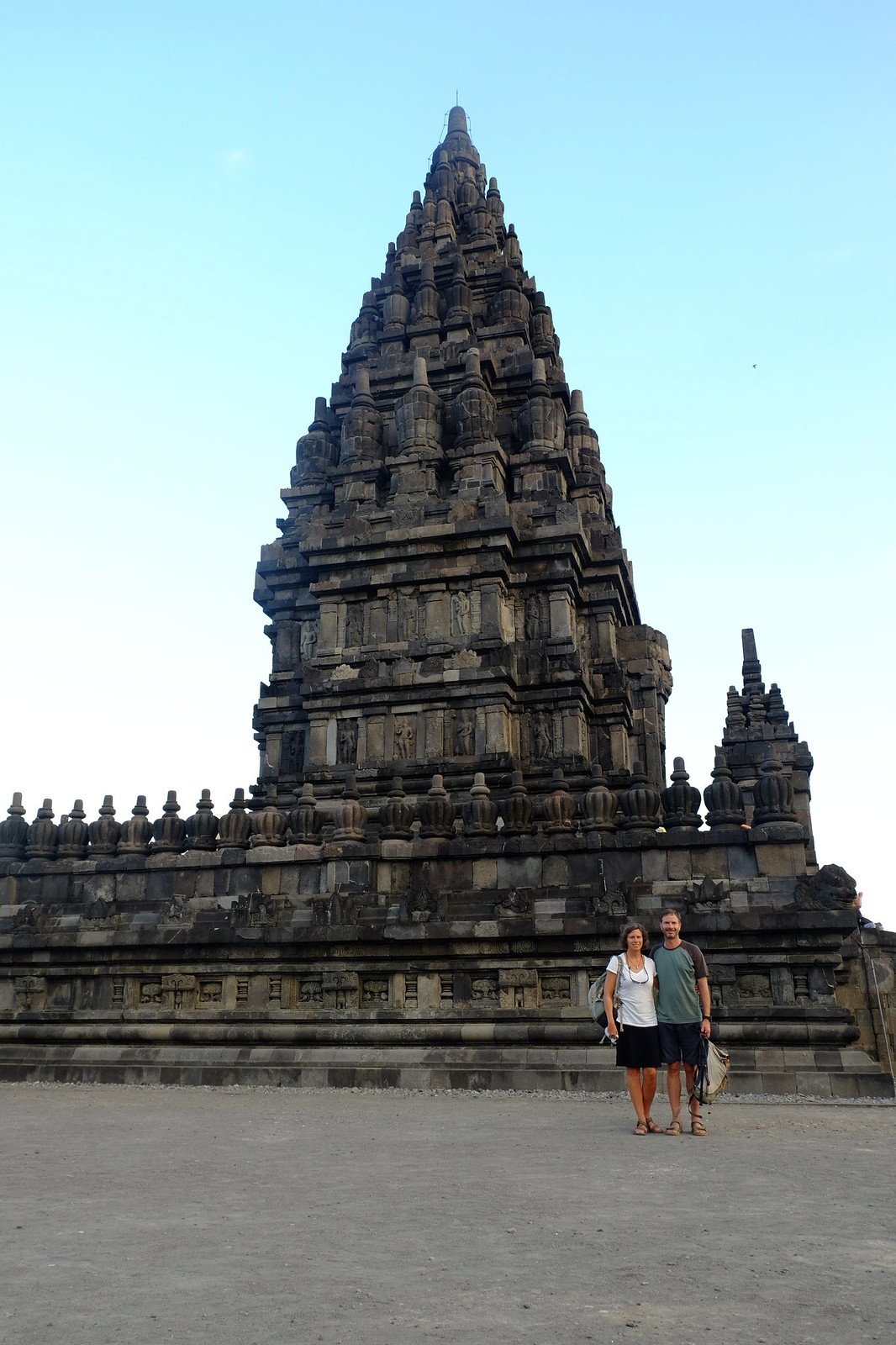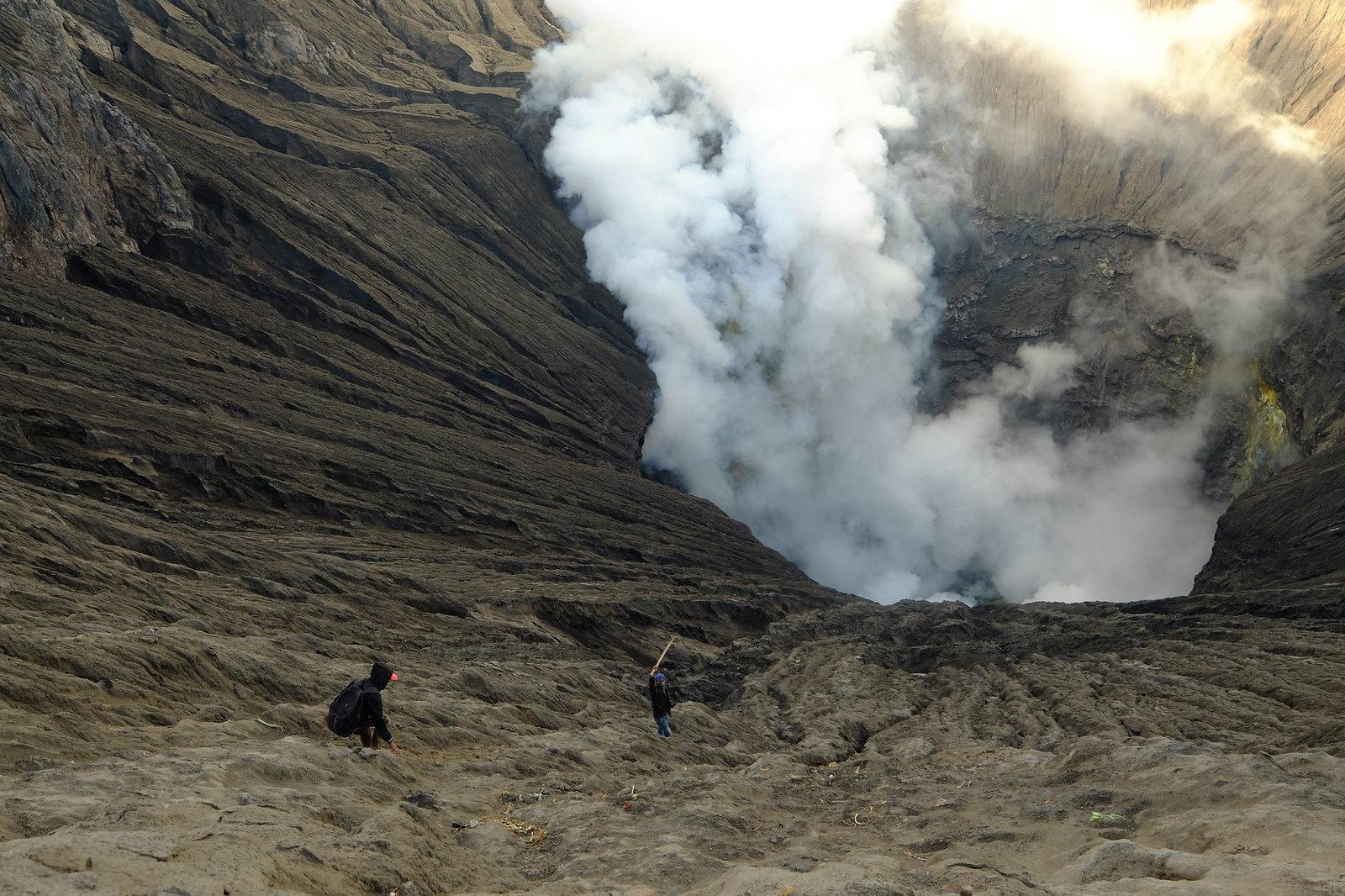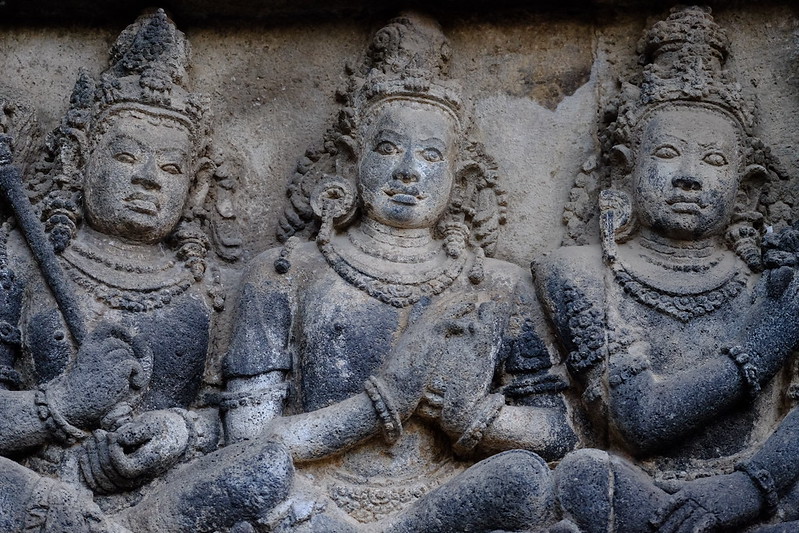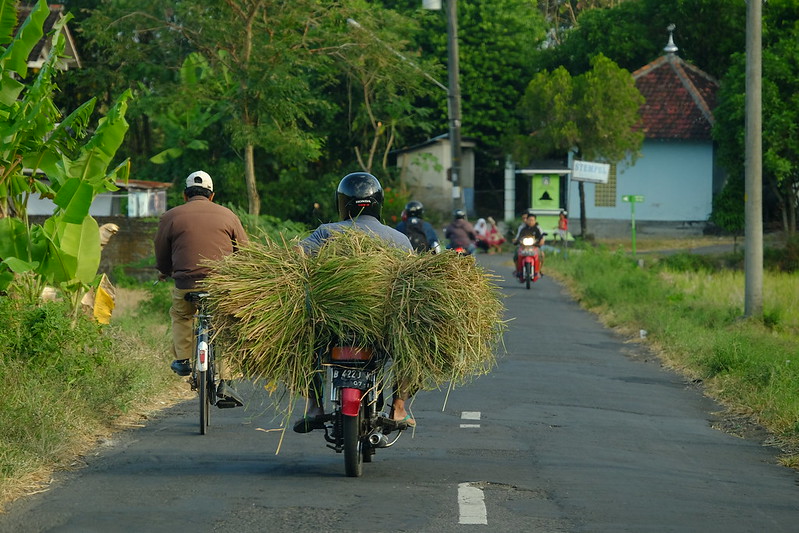We’ve read that if you haven’t been to Bali, you haven’t really been to Indonesia. I think it’s actually the opposite: if you’ve only been to Bali, you haven’t really been to Indonesia. We weren’t up for a whirlwind, multi-island tour, but wanted to see another island so on the advice of our friend Milton, we headed over to nearby Java to see two UNESCO World Heritage sites outside the city of Jogjakarta (aka Yogyakarta). After which we had a bit of an adventure, East Java-style.
Java feels totally different than Bali, primarily due to the differences between Muslim and Hindu cultures. A great majority of the women wear hijabs (headscarves). Javanese food is similar but different: it’s generally not as spicy, they use prepared sauces in their cooking, and there is no pork here but beef abounds. As in Bali, we found that nearly everyone rode scooters and so the crazy traffic remained the same. Thankfully Peter is a skilled scooter driver with the right balance of assertive and defensive driving habits, both of which are crucial to getting anywhere, and safely.
The two World Heritage sites near Jogja are Borobudur and Prambanan, temples built in the 8th and 9th centuries, respectively. Both are definitely worth seeing and they are close enough to each other to visit in the same day. We went to Borobudur in the late morning and to Prambanan at sunset.
Borobudur is the world’s largest Buddhist temple, with nine levels, more than 2,500 intricately carved panels, and over 400 Buddha statues. The top levels are full of stupas, which look like bells. Each stupa has a Buddha statue inside of it, which you can see through the stupa ‘windows.’ Aside from the impressive temple, the views from the temple are also beautiful. It is Indonesia’s number one tourist attraction for Indonesians and foreigners, and it’s easy to see why.
 View from near the top of Borobudur.
View from near the top of Borobudur.
In contrast to Borobudur, Prambanan is a complex of several Hindu temples, the largest in Indonesia. The Hindu architecture differs drastically from the Buddhist architecture of Borobudur. The temples are sharply pointed and tall, the tallest being over 150 feet, with intricate carvings as well. We saw a few Buddha statues in some of the temples but the main decoration is the carving on the exterior walls. Sunset was an ideal time to go because we escaped the midday heat and the throngs of tourists, and we were treated to a very nice sunset.
 One of the temples of Prambanan.
One of the temples of Prambanan.
Java is also famous for batik, which is a many centuries-old method of wax-resist fabric dyeing. Basically wax is applied on white cotton or silk by hand, then dye is applied, then the wax is removed. The areas where the wax had been remain white. Garments made from fabric that has been machine-dyed to look like batik are everywhere and a dime a dozen on Bali and Java. Real batik is quite expensive, but fairly easy to find in Jogjakarta due to the number of batik factories where men and women still apply the wax and dye by hand. Traditional batik is stamped with heavy copper stamps that are about 8” x 10” or so in a repeat pattern. The stamps are dipped in wax, then applied to the fabric, then dipped, applied, etc. After that, small dots of wax are applied to the (yards of) fabric, one by one. Then it’s dyed. Batik classes are offered, so we decided to do a six-hour class and take home a unique souvenir. The batik technique is also used for what end up looking like paintings on fabric, which is what we made in the class. It was fun to do something creative, and we got to take home the tool used to apply the wax so maybe we’ll do it again some day!
 Peter creating his batik masterpiece.
Peter creating his batik masterpiece.
While in Jogja, we learned of some impressive volcanoes in East Java, namely Gunung Bromo and Kawah Ijen, the latter sporting “blue fire.” The fire doesn’t come from lava, it’s the color of ignited sulfuric gas, and is a pretty rare phenomenon. Every tout in Jogja was selling 3-day/2-night Bromo/Ijen tours to the backpackers. Since we were both fighting colds, and didn’t have much time or energy to figure out how to visit these volcanos independently, we joined the backpacker trail and signed up for a tour through our homestay. Our host warned us that East Java is very different. He explained that he people aren’t very nice and don’t know how to cater to tourists. The accommodations aren’t nice, and you’ll be asked to pay for entrance tickets to the parks but you’ll never be given a ticket or ever asked by anyone to see these tickets. There were a few “best of the worst” comments about the accommodations and the tour company. Undeterred, we signed up.
There is this thing about getting to the tops of volcanoes in time to see the sunrise. Some people love it, and to each his own for sure. We’ve done it before and feel it’s somewhat overrated because of the crowds, the cold temperature, and the time you have to get up to see it. Plus, you may or may not be treated to a spectacular sunrise. The package Bromo/Ijen tours include seeing each of them at sunrise, which translates to leaving at 3:30 a.m. for Bromo the first morning, and either 12:30 a.m. for Ijen if you want to see the blue fire (because it has to be completely dark to see it), or 3:30 if you just want to see it at sunrise the following morning.
After spending 10+ hours the first day traveling from Jogja, we got to our homestay near Bromo pretty late and the accommodation lived up to our host’s warning. It was pretty bad, but we were only there to sleep for a few hours, so who cared. The worst was that, unbeknownst to us, the apparently the water heater for several rooms was on the main wall in our room and leaked during the very early morning when others were showering at like 2:00 a.m., depositing a lot of water on our floor. We were glad to get into the waiting Jeep at 3:30.
The top of Bromo itself sits at 2,600 meters, and the viewpoint we were driven to is across a valley from it and quite a bit higher. It was FREEZING. I had on a down jacket and had I known we were going to sit there, waiting in the dark for the sunrise for 90 minutes, I would have brought my sleeping bag to wrap up in. They truck everyone up there in a caravan of Jeeps, which Peter aptly named the Great Bromo Cattle Drive, where we are the cattle. My bet is that some guides started going earlier than necessary so their customers got the best spots, then everyone started doing it and now you’re up there with hundreds of other tourists Way. Too. Early. For me, it was ultimately worth it because the scenery in that light was quite spectacular. Peter, who had chosen to leave his down coat behind, was miserable and would never recommend doing it at sunrise, for any reason whatsoever. But I know, and he knows, it was because he took the wrong coat.
 Mercifully, sunrise finally came and revealed this. Bromo is the one on the left belching sulfuric fumes. The tallest volcano on the upper right also sputtered a bit.
Mercifully, sunrise finally came and revealed this. Bromo is the one on the left belching sulfuric fumes. The tallest volcano on the upper right also sputtered a bit.
After sunrise, the cattle returned to our Jeeps and were trucked over to the base of Bromo to walk to the top. The volcano was belching its sulfuric fumes and roaring; at certain spots on the rim the roar was nearly deafening. It was something to behold. We’ve never heard an active volcano like that, and will never forget it. I felt like I was looking at the entrance to hell.
 Two (crazy) young boys descending into Bromo’s awesome crater.
Two (crazy) young boys descending into Bromo’s awesome crater.
fter this, we traveled another 10 hours to arrive around 7:00 at the very worst hotel we’ve ever stayed in, near Ijen. To paint this pretty picture, our maroon toilet, with its unattached, faded maroon toilet seat, dispersed its liquid contents all over the bathroom floor when flushed. Then, we heard a loud bang around 10:00 pm that sounded like a bomb, followed by a scream. A few doors down from our room, a wall mounted water heater had literally blown up while someone was showering. She was not hurt, but no one from the hotel staff even came to investigate. If all that wasn’t bad enough, a horrible screeching noise woke us up after we had been asleep for about 90 minutes. I laid there for at least five minutes, silently cursing whoever set their alarm and wasn’t waking up, while Peter laid there with his pillow over his head silently cursing the hotel staff for making everything as horrible as possible for everyone. Shame on us, it was the water faucet in our lovely bathroom. I turned it off and it stopped, only to begin screeching anew 20-30 minutes later. So we let it run all night. This was my last straw. Our colds were worse, we had gotten less than 3 hours of sleep the previous night, and we see blue fire every time we turn on our gas burner at home, what’s the big deal. So, we slept in until 3:30. Incidentally, although I’m sure it beats a gas burner, the photos of the blue fire we saw from that morning looked nothing like the photos on the internet. Decision justified.
We arrived at Ijen and started the very steep, 4 km hike to the rim in darkness. On the way we passed some of the sulfur miners who make this trek every day, down into the crater and its toxic fumes to break off pieces of sulfur that they then carry out in baskets on their back — 80 kg (175 lbs) at a time — for ridiculously little money. They can’t even afford to buy gas masks. Clearly, none of the “entrance fees” we paid are benefiting these miners. If you’re interested, here is a good article with photos: http://www.bbc.com/news/world-asia-pacific-12301421.
We smelled the sulfur on the way up, and when at the crater rim, could see the miners (and tourists with their masks) moving in and out of the fumes by the lake in the crater. Due to the sulfur, the lake has a pH level of 0.5 – 0.13, more acidic than battery acid.
 Sulfur miner posing for tourists.
Sulfur miner posing for tourists.
 Kawah Ijen’s crater with its yellow sulfur and acidic lake.
Kawah Ijen’s crater with its yellow sulfur and acidic lake.
Photos taken, we hiked back down to get on another mini bus, which after several hours transferred us to a real bus that got on a ferry back to Bali. Along the way, we had been told numerous lies by the tour company, the last of which was that the bus they put all of us on went to Denpasar, Bali, where everyone was headed. Of course we weren’t given actual tickets to the bus, they “handle” all that for you. Problem was the bus didn’t go to Denpasar, it stopped 20 km short of Denpasar so everyone had to pay local, overpriced drivers to get to the destination we had already paid to get to on the bus.
When it was all over, we wrote to our Jogja host and told him there was a huge business opportunity for someone to come in and run a proper tour here, and he should do it. This was when he told us thanks, but East Java is controlled by the mafia. Which explained everything. The moral of this story is, the volcanoes are truly awesome, but if you go, take the time to research how to do it independently and don’t just sign up for a tour!
For more pictures, click through the below:
























6 replies